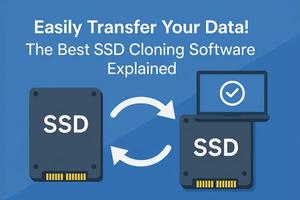Windows Data Recovery Software - Stellar Data Recovery Recovers Lost, Deleted, or Formatted Files

Key Takeaways
Essential insights to remember
Stellar Data Recovery offers three editions (Standard, Professional, Premium) with increasing capabilities, from basic file recovery to advanced features like photo repair.
The software's user-friendly interface makes recovery accessible to everyone, with clear step-by-step guidance and file preview before recovery.
Advanced capabilities include recovery from formatted drives, lost partitions, encrypted media, and severely damaged storage with deep scanning technology.
The software supports hundreds of file types across multiple categories, with compatibility for all Windows versions and multiple storage device types.
Acting quickly after data loss and following best practices significantly improves recovery success rates, as does saving recovered files to a different drive.
Introduction
In today's digital world, data loss can strike at any moment—a mistaken deletion, unexpected system crash, or corrupted storage device can instantly wipe out precious memories and critical files. 🚨 For Windows users faced with such data catastrophes, Stellar Windows Data Recovery Software emerges as a comprehensive lifeline, designed to retrieve what seemed irretrievably lost.
This powerful recovery solution stands out for its intuitive interface and extensive recovery capabilities, making it accessible for both novices and tech professionals alike.
With an impressive Trustpilot rating of "Excellent" based on 1,062 verified reviews, Stellar Data Recovery has established itself as a trusted ally in the fight against data loss. Whether you're attempting to recover cherished family photos, crucial business documents, or essential system files, this software offers a beacon of hope when digital disaster strikes.
What is Stellar Data Recovery?
Stellar Data Recovery (formerly known as Stellar Phoenix) represents a culmination of decades of expertise in data recovery technology. 💾 The software has evolved significantly since its inception, transforming into a sophisticated yet accessible solution for retrieving lost digital assets. The current iteration, version 12.0.0 released in January 2025, stands as a testament to continuous innovation and refinement.
Company Evolution
The journey from Stellar Phoenix to today's Stellar Data Recovery reflects a commitment to adapting to the ever-changing digital landscape. This metamorphosis wasn't merely cosmetic—each evolution brought enhanced algorithms, expanded file type support, and improved recovery techniques.
Available Editions
Stellar Data Recovery offers multiple tiers to accommodate various recovery needs and budgets:
- Standard Edition: Perfect for basic recovery of deleted files and formatted drives
- Professional Edition: Enhanced with lost partition recovery and bootable media support
- Premium Edition: The world's first Windows recovery software with photo and video repair capabilities
- Technician Edition: Designed for IT professionals with commercial recovery needs
- Toolkit Edition: The ultimate package for data recovery specialists
Each edition builds upon the previous one, creating a comprehensive ecosystem that addresses virtually every data loss scenario imaginable. This tiered approach ensures users only pay for the specific recovery capabilities they require—embodying the principle of "pay for what you need, not what you don't."
Key Features and Capabilities
The robust functionality of Stellar Data Recovery extends far beyond simple file retrieval, offering a comprehensive arsenal of recovery tools designed to address virtually any data loss situation. 🛠️ What truly distinguishes this software is its remarkable versatility across file types, storage media, and recovery scenarios.
File Recovery Capabilities
Stellar excels in recovering a vast spectrum of file formats:
- Documents: DOC, DOCX, PDF, XLS, XLSX, PPT, PPTX and dozens more office formats
- Emails: PST, MSG, EDB, MBOX, NSF, EML, DBX and numerous other email containers
- Multimedia: JPEG, PNG, RAW photo formats, MP4, MOV, MP3, WAV and hundreds of audio/video extensions
- Archive Files: ZIP, RAR, 7Z and various compression formats
The software employs advanced signature scanning technology, enabling it to recognize and recover hundreds of file types—even when file system information is severely damaged.
Storage Device Support
Stellar demonstrates exceptional adaptability across storage technologies:
- Traditional Media: Hard disk drives, SSDs, USB drives
- Removable Storage: SD cards, memory sticks, external drives
- Network Storage: Support for QNAP, ASUSTOR, and Synology NAS devices with BTRFS file systems
Recovery Scenarios
The software adeptly handles diverse data loss situations:
- Accidental Deletion: Recovers shift-deleted files bypassing the Recycle Bin
- Formatting Issues: Retrieves data from formatted or reformatted drives
- Corruption Challenges: Salvages files from corrupted or damaged storage media
- System Failures: Rescues data following virus attacks, system crashes, or power outages
Advanced Recovery Features
Beyond standard recovery functions, Stellar offers specialized capabilities:
- BitLocker Support: Reclaims data from encrypted drives (password required)
- RAW Recovery: Extracts data from severely corrupted physical or removable storage
- Deep Scan Technology: Performs sector-by-sector analysis to uncover deeply buried data
- File System Compatibility: Seamlessly works with FAT, NTFS, and exFAT partitions
This comprehensive feature set establishes Stellar Data Recovery as a versatile solution capable of addressing virtually any data loss predicament—from simple file deletions to complex recovery scenarios involving severely compromised storage media.
User Interface and Experience
Stellar Data Recovery combines powerful recovery capabilities with a remarkably intuitive interface that doesn't intimidate novice users. 🖥️ The software's design philosophy centers on accessibility without sacrificing functionality—striking a delicate balance that few recovery tools achieve.
Streamlined Design
The moment you launch Stellar Data Recovery, its clean, modern interface welcomes you with a logical workflow that guides you through the recovery process step by step. This thoughtful design eliminates the confusion and technical intimidation often associated with data recovery software.
Personalized Themes
To enhance user experience, Stellar offers three distinct visual themes:
- Dark Theme: Reduces eye strain during extended recovery sessions
- Light Theme: Provides clear visibility in bright environments
- Vibrant Theme: Adds visual engagement with colorful accents
This personalization extends beyond mere aesthetics—each theme maintains consistent navigation cues, ensuring users can switch without relearning the interface.
Intuitive Recovery Workflow
The software's wizard-driven approach simplifies the recovery process into logical stages:
- Select what types of files to recover
- Choose where to search for lost data
- Select scanning method (Quick or Deep)
- Preview and select files for recovery
- Designate a safe location to save recovered files
This sequential approach transforms what could be an overwhelming technical process into a series of manageable decisions.
Preview Functionality
One particularly valuable feature is the ability to preview recoverable files before committing to the recovery process. This preview capability:
- Confirms the recoverability of important files
- Verifies file integrity before full recovery
- Saves time by focusing recovery efforts on viable files
- Offers full-screen preview for video files
Enhanced Productivity Features
Stellar incorporates several workflow enhancements that significantly improve the recovery experience:
- Dual Monitor Support: Allows simultaneous tasks across two screens without toggling
- Pause & Resume: Enables interruption of long scans without losing progress
- File Sorting Options: Organizes results by file type, tree view, or deletion status
- Search Functionality: Quickly locates specific files among thousands of results
These thoughtful interface decisions demonstrate Stellar's understanding that effective data recovery requires not just powerful algorithms, but also a responsive, user-friendly experience that respects users' time and reduces anxiety during what is often a stressful situation.
How Stellar Data Recovery Works
The recovery process with Stellar Data Recovery follows a methodical, step-by-step approach designed to maximize successful data retrieval while minimizing user confusion. 🔍 Understanding this workflow can significantly improve your recovery outcomes and efficiency.
Step 1: Select Data Types
The journey begins by specifying what file types you wish to recover:
- Choose "All Data" for comprehensive recovery
- Select specific categories (photos, videos, documents, etc.) to streamline the process
- Use "Custom" to target particular file extensions not listed in standard categories
This selective approach prevents the software from wasting time scanning for irrelevant file types, potentially accelerating the recovery process.
Step 2: Location Selection
Next, you'll identify where to search for your lost data:
- Connected Drives: Internal and external storage devices currently attached
- Physical Disks: Storage media at the hardware level, useful when partitions aren't visible
- Common Locations: Quick access to Desktop, Documents, and other frequently used folders
- Can't Find Drive Option: For recovering from severely damaged or unrecognizable storage
The software displays detailed drive information, including free/used space and physical disk characteristics, helping you make an informed selection.
Step 3: Scanning Options
Stellar offers two distinct scanning methodologies:
Quick Scan
- Rapidly parses file system tables
- Ideal for recently deleted files
- Completes within minutes for most drives
- Less thorough but significantly faster
Deep Scan
- Performs comprehensive sector-by-sector analysis
- Employs file signature recognition technology
- Can take several hours depending on drive size
- Significantly more thorough for challenging recovery scenarios
A toggle switch makes transitioning between these options effortless, allowing users to start with a quick scan and escalate to deep scan only if necessary.
Step 4: Preview and Recovery
After scanning completes, results appear in three intuitive views:
- File Type View: Organizes by file categories (documents, images, etc.)
- Tree View: Presents familiar folder hierarchy structure
- Deleted List: Shows only deleted files for focused recovery
The preview pane displays file contents before recovery, with specialized viewers for different file types—text preview for documents, thumbnails for images, and playback for media files.
Step 5: Save Recovered Data
The final step involves selecting recovered files and choosing a safe destination:
- Important: Never save recovered files to the same drive they were lost from
- Select individual files or entire folders for recovery
- Choose an alternative storage location (preferably on different physical media)
- Monitor the recovery progress with detailed status indicators
Advanced Feature: Pause and Resume
One particularly valuable capability is the ability to pause ongoing scans:
- Interrupt lengthy scans when necessary
- Resume from the same point later without data loss
- Manage system resources during intensive scanning
- Schedule scans during convenient times
This methodical, user-guided approach transforms what could be an intimidating technical process into a logical sequence of decisions, ensuring even non-technical users can successfully navigate complex recovery scenarios.
Pricing and Edition Comparison
Understanding Stellar Data Recovery's pricing structure is essential for selecting the edition that aligns perfectly with your specific recovery needs and budget. 💰 The software employs a tiered pricing model, with each successive tier unlocking additional recovery capabilities while building upon the foundation of the previous edition.
Standard Edition ($59.99)
The entry-level offering provides robust recovery capabilities for common data loss scenarios:
- Recovers deleted photos, videos, and critical files
- Retrieves data from formatted systems
- Works with virtually any storage media
- Recovers data from encrypted drives
At $59.99 (discounted from the regular price), the Standard Edition represents excellent value for individuals seeking straightforward recovery of accidentally deleted files or formatted drives.
Professional Edition ($89.99)
The mid-tier Professional Edition (marked as "Best Seller") enhances recovery capabilities with several advanced features:
- Includes all Standard Edition functionality
- Adds recovery from lost or deleted partitions
- Supports unbootable system recovery
- Enables data recovery from CD/DVD media
- Includes Drive Monitor to track storage health
Priced at $89.99 (reduced from actual price), this edition offers significantly expanded functionality for more challenging recovery scenarios, making it ideal for professionals and small businesses dealing with complex storage issues.
Premium Edition ($99.99)
The flagship Premium Edition adds specialized repair capabilities beyond mere recovery:
- Incorporates all Professional Edition features
- Pioneering photo and video repair functionality
- Repairs corrupt or distorted videos
- Fixes damaged image files
- One-click batch repair for multiple files
At $199 (substantially discounted from the regular price), the Premium Edition delivers exceptional value for multimedia professionals and photography enthusiasts who need both recovery and repair capabilities.
Value Proposition
Each edition is strategically priced to offer clear value corresponding to its capabilities. The Standard Edition provides essential recovery at an accessible price point, while Professional adds specialized recovery for more complex scenarios. The Premium Edition's unique repair capabilities justify its position as the top-tier option, particularly for users with valuable multimedia assets.
““Pro Tip: Assess your recovery needs carefully before purchasing. While the Premium Edition offers the most comprehensive feature set, the Professional Edition may suffice for most business users, and the Standard Edition often meets typical home user requirements.
All editions come with a single-system license and the same core recovery engine, ensuring that even the entry-level option delivers professional-grade recovery capabilities for its intended use cases.
System Requirements
Before embarking on your data recovery journey with Stellar, ensuring your system meets the necessary specifications is crucial for optimal performance. 🖥️ Stellar Data Recovery is engineered to operate efficiently on most modern Windows systems without demanding cutting-edge hardware, making it accessible to a broad spectrum of users.
Hardware Requirements
Processor Specifications
Stellar Data Recovery requires an Intel-compatible x64-based processor. The software is optimized for 64-bit architecture to handle complex recovery algorithms efficiently. While the software will function on modest processors, recovery speed—particularly during deep scans—improves significantly with more powerful CPUs.
Memory Considerations
- Minimum Requirement: 4 GB RAM
- Recommended Specification: 8 GB RAM or higher
Memory utilization becomes particularly significant during deep scans of large storage devices. Insufficient RAM won't prevent recovery but may extend processing time considerably. The relationship between memory and performance follows a logarithmic curve—the benefit of additional RAM becomes less pronounced beyond 16 GB for most recovery scenarios.
Storage Requirements
The software installation requires a modest 250 MB of free space on your system drive. However, you'll need substantially more free space on a separate drive to store recovered files. A prudent approach is to ensure you have at least as much free space as the volume of data you're attempting to recover.
Operating System Compatibility
Stellar Data Recovery offers comprehensive support across the Windows ecosystem:
- Windows 11
- Windows 10
- Windows 8.1
- Windows 8
- Windows Server 2022
- Windows Server 2019
- Windows Server 2016
This broad compatibility encompasses virtually the entire active Windows user base. However, note that the software is exclusively available for 64-bit versions of these operating systems, reflecting the industry-wide transition away from 32-bit architecture.
Additional Compatibility Notes
- TPM Chip Compatibility: The software functions seamlessly on systems with Trusted Platform Module chips, without triggering security concerns.
- High-DPI Displays: Stellar Data Recovery is optimized for modern high-resolution displays, maintaining interface clarity without scaling issues.
- Multilingual Support: The software includes extensive language support, including English, Deutsch, Français, Português Brasileiro, Dutch, Italiano, Español, 日本語, 한국어, हिंदी, and 中国人.
““Important Consideration: While Stellar Data Recovery has modest system requirements, recovery performance scales with hardware capabilities. For very large drives (multiple terabytes) or extensive deep scans, exceeding the minimum requirements—particularly for processor and RAM—can substantially reduce recovery time.
The accessibility of these system requirements ensures that Stellar Data Recovery remains a viable solution across a diverse range of hardware configurations, from budget laptops to high-performance workstations. This inclusivity aligns with the software's philosophy of making professional-grade data recovery accessible to all users, regardless of technical expertise or hardware investment.
Practical Use Cases
Stellar Data Recovery's versatility shines brightest when examining its real-world applications. 🌟 Understanding these scenarios illuminates the software's practical value beyond abstract feature lists, demonstrating its efficacy in addressing genuine data crisis situations.
Recovery After Accidental Formatting
Perhaps one of the most common data disasters occurs during Windows installation when users inadvertently format the wrong drive. Stellar Data Recovery excels in this scenario through its powerful volume reconstruction capabilities:
““"While installing Windows, I accidentally formatted the drive and then installed Windows. Stellar Data Recovery helped me recover nearly all my data that wasn't overwritten by the new OS files."
The recovery process involves:
- Using the "Can't Find Drive" option to identify lost volumes
- Performing a deep scan to reconstruct the previous file system
- Recovering data from partitions not overwritten by the new Windows installation
This capability proves invaluable during system upgrades gone wrong—a situation where anxiety runs high and the financial or sentimental value of lost data can be substantial.
Lost Partition Recovery
Storage partitions can disappear due to partition table corruption, accidental deletion, or failed disk management operations. Stellar's "Extensive Partition Search" feature systematically reconstructs these missing volumes:
- Scans drive at the sector level to identify partition signatures
- Reconstructs volume structures using file system markers
- Recovers data even when Windows shows the space as "unallocated"
- Works with both recently lost partitions and long-deleted volumes
This capability often appears miraculous to users who believed their data was permanently lost after partition table damage.
Long-Unused Hard Drive Recovery
Stellar demonstrates impressive capability when recovering data from drives unused for extended periods (3+ years). Such recovery poses unique challenges:
- Magnetic field degradation (approximately 1% per year)
- Potential mechanical deterioration
- Possible environmental damage from improper storage
Despite these obstacles, the software's advanced algorithms can often reconstruct data from long-dormant drives, provided they remain physically functional.
File-Type Specific Recovery
When users need to recover specific file categories rather than entire volumes, Stellar's targeted recovery proves remarkably efficient:
- Photo-Only Recovery: Particularly valuable for recovering images from memory cards
- Document Recovery: Prioritizes business-critical files like spreadsheets and PDFs
- Email Recovery: Specializes in rebuilding email containers including PST, EDB, and MBOX files
This selective approach conserves time and computational resources, focusing exclusively on high-value targets rather than sifting through unneeded file types.
Recovery from External and Removable Media
Beyond internal drives, Stellar excels at recovering data from portable storage:
- Memory cards from cameras and mobile devices
- USB flash drives subjected to improper ejection
- External hard drives with logical (non-physical) damage
The software's ability to work across diverse storage architectures ensures consistent recovery capabilities regardless of the device that experienced data loss.
These practical applications highlight Stellar Data Recovery's role as both an emergency response tool for acute data loss incidents and a methodical recovery solution for more complex scenarios. By addressing these real-world use cases effectively, the software transforms potentially devastating data loss situations into manageable, solvable problems.
Tips and Best Practices
Successful data recovery extends beyond software capabilities to encompass proper techniques and preventative measures. 💡 Implementing these expert-recommended practices will significantly enhance your recovery success rate while minimizing the risk of permanent data loss.
Before Data Loss Occurs
The ancient adage "an ounce of prevention is worth a pound of cure" applies perfectly to data protection. Proactive measures dramatically improve recovery outcomes:
- Regular Backups: Establish automated backup routines to multiple destinations
- 3-2-1 Backup Strategy: Maintain three copies, on two different media types, with one copy off-site
- Verify Backup Integrity: Periodically test restores to confirm backup functionality
- Update Storage Devices: Replace aging drives before they reach statistical failure points
These preventative measures create multiple safety nets that reduce reliance on recovery software when disasters strike.
During a Data Loss Incident
The moments immediately following data loss are critical. Your actions during this window can determine whether recovery is trivial or impossible:
- Stop Using the Affected Drive: Every write operation potentially overwrites recoverable data
- Avoid "Quick Fixes": Don't run CHKDSK or other repair utilities before recovery attempts
- Don't Reinstall Applications: Software installation may overwrite recoverable files
- Disconnect from Internet: Prevents automatic updates or syncing that could overwrite data
““Critical Warning: The golden rule of data recovery is "do no harm." When in doubt, power down the system and seek professional guidance before taking any action that writes to the affected drive.
Optimizing Stellar Data Recovery Usage
To maximize recovery success with Stellar Data Recovery:
- Save to Different Drive: Never recover files to the same drive you're recovering from
- Start with Quick Scan: Use the faster scanning option first, escalating to Deep Scan only if necessary
- Prioritize Critical Files: Recover your most important files first in case the recovery process is interrupted
- Use Preview Function: Verify file integrity before committing to full recovery
- Custom File Type Recovery: Add specific extensions if your file types aren't included in preset categories
Storage Device Maintenance
For external and rarely used drives:
- Store in Controlled Environment: Maintain cool, dry conditions (60-75°F, 35-50% humidity)
- Periodic Refreshing: Connect and transfer data to/from drives at least annually
- Proper Shutdown: Always use "Safely Remove Hardware" before disconnecting external devices
- Check Drive Health: Utilize S.M.A.R.T. monitoring tools quarterly to detect early warning signs
Understanding Recovery Limitations
Even with powerful tools like Stellar Data Recovery, certain situations may exceed DIY recovery capabilities:
- Physical Damage: Clicking, grinding, or non-detected drives often require professional clean-room recovery
- Overwritten Data: Once new data has been written to a sector, previous data is generally irrecoverable
- Factory Reset/Secure Erase: Modern secure erasure methods may render recovery impossible
- SSD TRIM Operations: Solid-state drives with TRIM enabled may permanently erase deleted files
These limitations underscore the importance of prevention and timely action when data loss occurs.
By incorporating these best practices into your data management routine, you create a robust defense against permanent data loss. Remember that successful recovery is often determined by actions taken before and immediately after data loss occurs—making preparedness and proper response as important as the recovery software itself.





